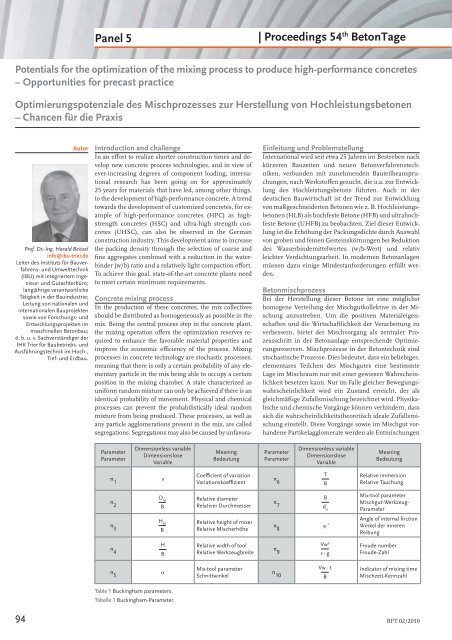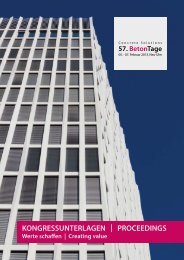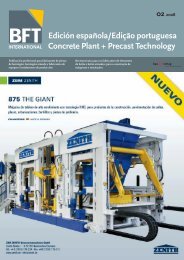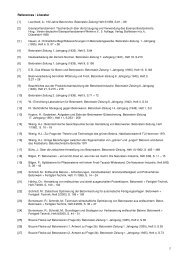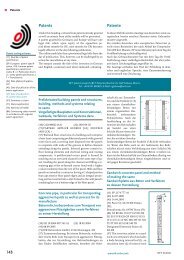Concrete Plant + Precast Technology Betonwerk ... - BFT International
Concrete Plant + Precast Technology Betonwerk ... - BFT International
Concrete Plant + Precast Technology Betonwerk ... - BFT International
Sie wollen auch ein ePaper? Erhöhen Sie die Reichweite Ihrer Titel.
YUMPU macht aus Druck-PDFs automatisch weboptimierte ePaper, die Google liebt.
94<br />
Panel 5<br />
Introduction and challenge<br />
In an eff ort to realize shorter construction times and develop<br />
new concrete process technologies, and in view of<br />
ever-increasing degrees of component loading, international<br />
research has been going on for approximately<br />
25 years for materials that have led, among other things,<br />
to the development of high-performance concrete. A trend<br />
towards the development of customized concretes, for example<br />
of high-performance concretes (HPC) as highstrength<br />
concretes (HSC) and ultra-high strength concretes<br />
(UHSC), can also be observed in the German<br />
construction industry. This development aims to increase<br />
the packing density through the selection of coarse and<br />
fi ne aggregates combined with a reduction in the waterbinder<br />
(w/b) ratio and a relatively light compaction eff ort.<br />
To achieve this goal, state-of-the-art concrete plants need<br />
to meet certain minimum requirements.<br />
<strong>Concrete</strong> mixing process<br />
In the production of these concretes, the mix collectives<br />
should be distributed as homogeneously as possible in the<br />
mix. Being the central process step in the concrete plant,<br />
the mixing operation off ers the optimization reserves required<br />
to enhance the favorable material properties and<br />
improve the economic effi ciency of the process. Mixing<br />
processes in concrete technology are stochastic processes,<br />
meaning that there is only a certain probability of any elementary<br />
particle in the mix being able to occupy a certain<br />
position in the mixing chamber. A state characterized as<br />
uniform random mixture can only be achieved if there is an<br />
identical probability of movement. Physical and chemical<br />
processes can prevent the probabilistically ideal random<br />
mixture from being produced. These processes, as well as<br />
any particle agglomerations present in the mix, are called<br />
segregations. Segregations may also be caused by unfavora-<br />
| Proceedings 54 th BetonTage<br />
Potentials for the optimization of the mixing process to produce high-performance concretes<br />
– Opportunities for precast practice<br />
Optimierungspotenziale des Mischprozesses zur Herstellung von Hochleistungsbetonen<br />
– Chancen für die Praxis<br />
Autor<br />
Prof. Dr.-Ing. Harald Beitzel<br />
info@ibu-trier.de<br />
Leiter des Instituts für Bauverfahrens-<br />
und Umwelttechnik<br />
(IBU) mit integriertem Ingenieur-<br />
und Gutachterbüro;<br />
langjährige verantwortliche<br />
Tätigkeit in der Bauindustrie;<br />
Leitung von nationalen und<br />
internationalen Bauprojekten<br />
sowie von Forschungs- und<br />
Entwicklungsprojekten im<br />
maschinellen Betonbau;<br />
ö. b. u. v. Sachverständiger der<br />
IHK Trier für Baubetriebs- und<br />
Ausführungstechnik im Hoch-,<br />
Tief- und Erdbau.<br />
Parameter<br />
Parameter<br />
π 1<br />
π 2<br />
π 3<br />
π 4<br />
π 5<br />
Dimensionless variable<br />
Dimensionslose<br />
Variable<br />
v<br />
D M<br />
B<br />
H M<br />
B<br />
H<br />
B<br />
Table 1 Buckingham parameters.<br />
Tabelle 1 Buckingham-Parameter.<br />
a<br />
Meaning<br />
Bedeutung<br />
Coeffi cient of variation<br />
Variationskoeffi zient<br />
Relative diameter<br />
Relativer Durchmesser<br />
Relative height of mixer<br />
Relative Mischerhöhe<br />
Relative width of tool<br />
Relative Werkzeugbreite<br />
Mix-tool parameter<br />
Schnittwinkel<br />
Einleitung und Problemstellung<br />
<strong>International</strong> wird seit etwa 25 Jahren im Bestreben nach<br />
kürzeren Bauzeiten und neuen Betonverfahrenstechniken,<br />
verbunden mit zunehmenden Bauteilbeanspruchungen,<br />
nach Werkstoff en gesucht, die u.a. zur Entwicklung<br />
des Hochleistungsbetons führten. Auch in der<br />
deutschen Bauwirtschaft ist der Trend zur Entwicklung<br />
von maßgeschneiderten Betonen wie z. B. Hochleistungsbetonen<br />
(HLB) als hochfeste Betone (HFB) und ultrahochfeste<br />
Betone (UHFB) zu beobachten. Ziel dieser Entwicklung<br />
ist die Erhöhung der Packungsdichte durch Auswahl<br />
von groben und feinen Gesteinskörnungen bei Reduktion<br />
des Wasserbindemittelwertes (w/b-Wert) und relativ<br />
leichter Verdichtungsarbeit. In modernen Betonanlagen<br />
müssen dazu einige Mindestanforderungen erfüllt werden.<br />
Betonmischprozess<br />
Bei der Herstellung dieser Betone ist eine möglichst<br />
homogene Verteilung der Mischgutkollektive in der Mischung<br />
anzustreben. Um die positiven Materialeigenschaften<br />
und die Wirtschaftlichkeit der Verarbeitung zu<br />
verbessern, bietet der Mischvorgang als zentraler Prozessschritt<br />
in der Betonanlage entsprechende Optimierungsreserven.<br />
Mischprozesse in der Betontechnik sind<br />
stochastische Prozesse. Dies bedeutet, dass ein beliebiges,<br />
elementares Teilchen des Mischgutes eine bestimmte<br />
Lage im Mischraum nur mit einer gewissen Wahrscheinlichkeit<br />
besetzen kann. Nur im Falle gleicher Bewegungswahrscheinlichkeit<br />
wird ein Zustand erreicht, der als<br />
gleichmäßige Zufallsmischung bezeichnet wird. Physikalische<br />
und chemische Vorgänge können verhindern, dass<br />
sich die wahrscheinlichkeitstheoretisch ideale Zufallsmischung<br />
einstellt. Diese Vorgänge sowie im Mischgut vorhandene<br />
Partikelagglomerate werden als Entmischungen<br />
Parameter<br />
Parameter<br />
π 6<br />
π 7<br />
π 8<br />
π 9<br />
π 10<br />
Dimensionless variable<br />
Dimensionslose<br />
Variable<br />
T<br />
B<br />
B<br />
d w<br />
w ’<br />
Vw 2<br />
r · g<br />
Vw · t<br />
B<br />
Meaning<br />
Bedeutung<br />
Relative immersion<br />
Relative Tauchung<br />
Mix-tool parameter<br />
Mischgut-Werkzeug-<br />
Parameter<br />
Angle of internal friction<br />
Winkel der inneren<br />
Reibung<br />
Froude number<br />
Froude-Zahl<br />
Indicator of mixing time<br />
Mischzeit-Kennzahl<br />
<strong>BFT</strong> 02/2010


